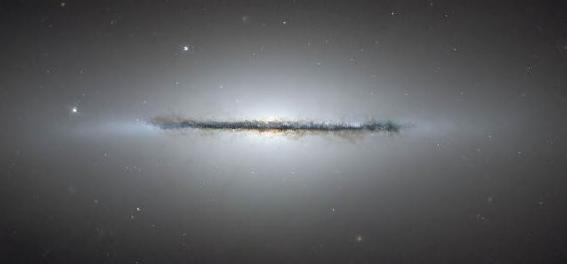

In connection with the Hubble Heritage image of NGC 5866, Phil Plait posed some interesting questions on the Bad Astronomy blog, and likewise a few writers in Webland have chimed in via email. Having my name acknowledged in the image release, I feel sort of bound to take my best shot at some musings on these.
What are these S0 galaxies, anyway?
The galaxy classification system that Edwin Hubble proposed 80 years ago still finds wide use. This system was originally set up to provide some sort of systematic shorthand description of galaxy photographs, but turns out to correlate well with the content and history of galaxies. His types are often arranged in a tuning-fork shape (see Ray White's layout with galaxy pictures) to display similarities, although this does not imply that an individual galaxy is evolving along the sequence. Hubble did not find, but postulated for continuity, a transition type between spiral and elliptical galaxies, which he called S0 (S-zero). Examples were later found, and turn out to be important constituents of galaxy clusters and to hold clues to the evolution of galaxies with cosmic time. Especially when seen edge-on, S0s are among the kinds of galaxies also known as lenticiular, for their lens-shaped outline. The textbook S0 has a bulge and disk, both old stars, no cool gas/dust for star formation. This may only be an approximation for many real galaxies we put in this box. These structural components show that S0s must be related to spiral galaxies, but exactly how?
Just how many paths there are to make S0 galaxies has been a long-running debate. Some of the proposed processes include:
Purely internal, or at least not too environmentally-sensitive, processes must be common - as Alan Dressler points out, most S0s are found outside of rich clusters, so ram-pressure stripping of their gas by the cluster medium can't be the whole story. And the mounting census of galaxy types with redshift shows that significant numbers of spirals are turning into S0s both in and out of clusters over timespans we can now trace (since about z=1, about 8 Gyr ago.
I became involved in the Hubble Heritage release because I needed Hubble data on edge-on S0 galaxies with dust for a comparative study, and found nothing in the archive for galaxies that are clearly S0 and have dust lanes. However, the Heritage team had just obtained the NGC 5866 data, so I got in contact with Lisa Frattare (who had been my first summer research student about 12 years ago). This is how I came to write much of the descriptive text in the release, and have an advance opportunity to stare at the complex dust in NGC 5866. So as far as I can tell, this is the first time we've seen the deilcate dust wisps poking out of the plane in S0 galaxies. Dust has been observed (particularly using Hubble) in a number of S0 galaxies before, but most of them are seen more face-on so we can trace the radial distribution, but the perpendicular structure is lost in the overall pattern. (Many of these do show patchy spiral patterns in the dust when seen in this level of detail - NGC 4526, which has a press-release HST image with a supernova, is an example). Others have amorphous dust, often near the nucleus, which some have suggested is condensing from hot gas associated with the central bulge (rather than the galaxy disks).
It is consistent with what we know to interpret the wisps in NGC 5866 as tracers of energy input by a relative handful of massive stars, as we see in edge-on spiral galaxies. The features absorb rather little light, so there is not as much dust off the plane as we see in such spirals as NGC 891, and far-IR data suggest that NGC 5866, like a fair fraction of S0s, continues a dribble of star formation (although not enough to clearly delineate spiral arms, or they would be called spirals). IR and H-alpha surveys have shown that the star-formation distinction between spirals and S0s is one of degree, rather than kind - some S0s do have detectable H I gas and low levels of massive-star formation. One distinction that remains could first be seen by composing inclination sequences of spirals and S0s (H.D. Curtis did this for spirals back in 1918 before people were even sure they were separate galaxies). It seems a pretty solid pattern, remarked on by Alan Sandage in the Hubble and Carnegie galaxy atlases. that the dust in spirals goes roughly as far out as the disk of stars, while in S0s it is confined to a smaller annulus (as in NGC 5866). This in itself tells us that there has been significant structural evolution in S0s since the disk stars formed; cold gas and dust are closely connected, and the outer disk stars formed in an area which has since been emptied of cold gas by one of the processes above (or more we haven't thought of). And in the most "classical" S0s, the process has gone to completion, leaving virtually no dust or cool gas in the disk.
How can a galaxy have a warp without a spiral?
Phil Plait's question is centered on the warp which is beautifully shown in the Hubble image. The dust lane is tipped with respect the disk of stars, which means at least that both are slightly warped potato-chip style (the warp may be the same for both, since we don't see the dust on the back side of the galaxy where there are too few stars to backlight it). Such warps are often triggered by the gravitational influence of passing galaxies, or even the ingestion of a small galaxy whole. Such encounters are also implicated in triggering bursts of star formation, and in exciting the internal wave modes in galaxy disks that produce the grand-design spiral patterns showing up in the standard galaxy pretty pictures. But S0 galaxies, by definition, don't have these spiral patterns. What gives?
Astronomers have known about (and been scratching heads over) warps in the disks of galaxies since early maps of atomic hydrogen in our own Milky Way (using the 21-cm line) showed that our own outer disk is distinctly not flat. Similar problems turned up in abundance - if you look very closely, Andromeda has a warp. The Triangulum Pinwheel Galaxy M33 seems to be warped. And a fair fraction of galaxies seen edge-on have warps. It's easiest to see when we see a galaxy's disk very close to edge-on (otherwise it's possibly to confuse a warp with a very open S-shaped spiral pattern seen almost end-on). You can see this in the "integral-sign" galaxy NGC 6045A in the Hercules cluster. Some clear examples of warped dust disks include the interacting pair NGC 7253AB, ESO 510-13, and the radio galaxy which got me into this question lately, 0313-192.
The abundance and simple structure of these warps suggests that there is something that we need to understand. The reason there is an issue with warps is that over time, a simply warped disk should "wrap up" in a tangled way. Material at different radii in a galaxy's gravitational field has different orbital periods, and to make it worse, if the galaxy is not spherical, the plane of the orbits will precess about the galaxy's poles at different rates. So the question is how long a warp stays easy to recognize against these effects that will smear one out - plus collisions of its dust and gas clouds with others from the galaxy disk, which will gradially flatten the warp into the galaxy's plane as well. The close to the center gas in a tilted piece of the disk orbits, the faster these processes should wrap a thin warp into something more like a vertical ribbon (or a giant model of the Ringworld).
Some of the things we'd like to know about them include
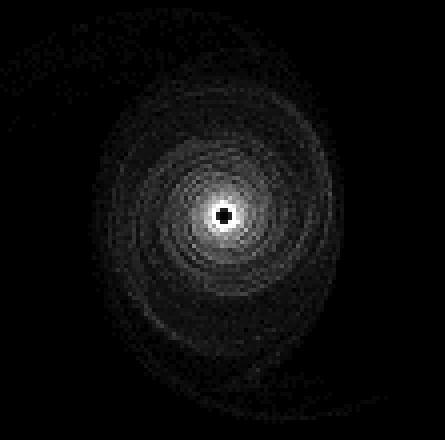 |
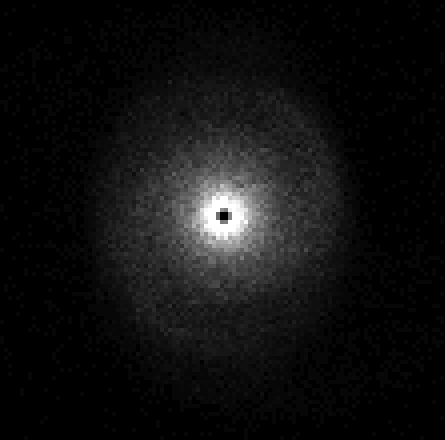 |
I know of two galaxies in the Hydra I cluster (Abell 1060) which may illustrate this kind of response. Projected close to the central galaxy NGC 3309 are two disk systems, PGC 31450 and 31464, which show very broad fanlike spiral patterns, much as models suggest result from tidal effects on stars alone with essentially no disk gas. These can be seen in the following excerpt from a photographic plate taken by Dan Weedman using the 4-meter Blanco telescope at Cerro Tololo Inter-American Observatory:
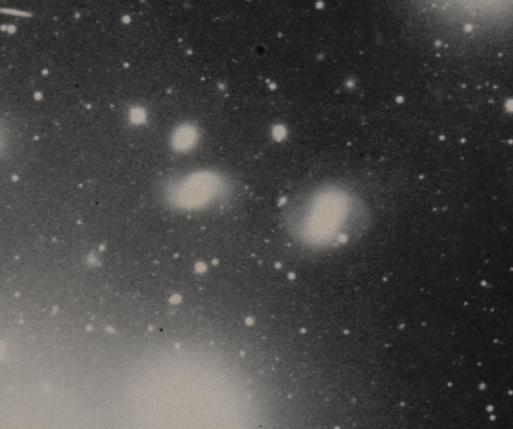
The outer envelope of NGC 3309 show up at the bottom. The "arms" in these two galaxies are sharp on one side and fade away very gradually on the other, in distinction to the narrower patterns we are familiar with from typical spiral galaxies. (And for those who think I have an unnecessarily narrow view of the Universe - I'll have you know that this piece of the sky is a full quarter degree from NGC 3314).
And anyway - if S0 galaxies have no ongoing star formation, how come they have any gas and dust left over? Answer number 1 - our initial picture of S0 galaxies was too simple, and some of them do still host star formation. Not much by the standards of the Milky Way, but it can be turned up by careful measurements of H-alpha emission from gas ionized by young stars or far-infrared detection of dust heated by these stars. Answer number 2 - and some of that star formation takes place down near the centers of the galaxies, where it has often been most difficult to see against the bright background of light from the old stars. Answer number 3 - there may be a puzzle as to why galaxies like NGC 5866 don't have more star formation in view of the amount of gas and dust we can see. (One politician said the problem with scientists was they had too many hands - "on the one hand", "on the other other hand...", and perhaps someday "on the gripping hand"). Pretty clearly, the sequence of traditional galaxy types is a continuous one - there are galaxies at any point along the sequence that we like to slice up as S0 - S0/a - Sa - Sab - Sb... as the relative amount of star formation goes up and the importance of the central bulge stars declines. So some S0 galaxies will be a bit more spiral-like in this context - and in fact, there are some in which Hubble has picked out that the dust, at least, is wound into tight, fragmentary spiral patterns (as in NGC 4526, nicely depicted in this picture with a type Ia supernova and which also gas both 21-cm gas and IR detection of warm dust). (Note, by the way, the sharp outer edge to its disk dust with respect to the stars, which is common in S0s but not in spirals - compare to the Sombrero).
S0 galaxies do almost always have less gas then in comparable spirals, at least the kinds of cool gas that can collapse under gravity to make stars. Some are as gas- and dust-free as we can tell - like NGC 3115 and 4762, shown here in images from the Hubble archive. Not a hint of absorbing dust; the epitome of the idealized S0. (By the way, in both NGC 3115 and NGC 5866, the detectable starlight from the galaxy spills well beyond the Hubble images).
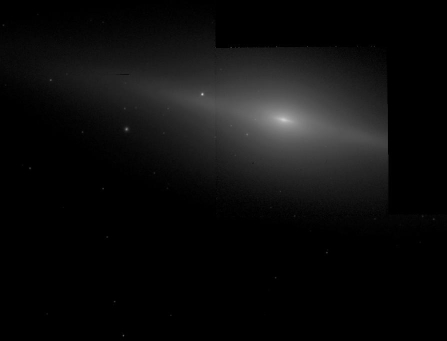 |
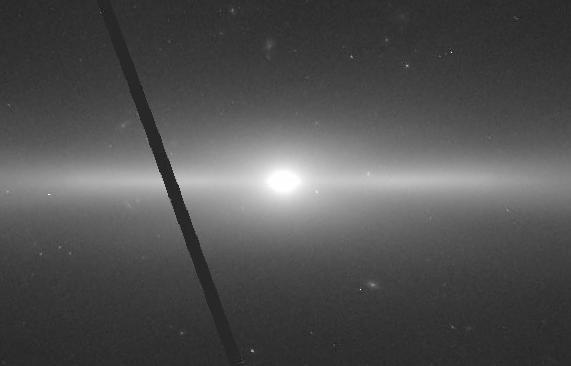 |
| NGC 3115 | NGC 4762 |
The smattering of dust in some S0 galaxies shows up not in a thin disk, but in odd patterns near the nucleus, which may be telling us that the dust is forming from hot gas where we see it and starts to settle toward the core, being blown around by movements of the hotter interstellar gas even as that gas starts to evaporate the miniscule dust grains. This shows up in NGC 4111, seen in a Hubble closeup below. (This was from a single exposure in the archive, peppered with an unusually ugly set of cosmic-ray hits).
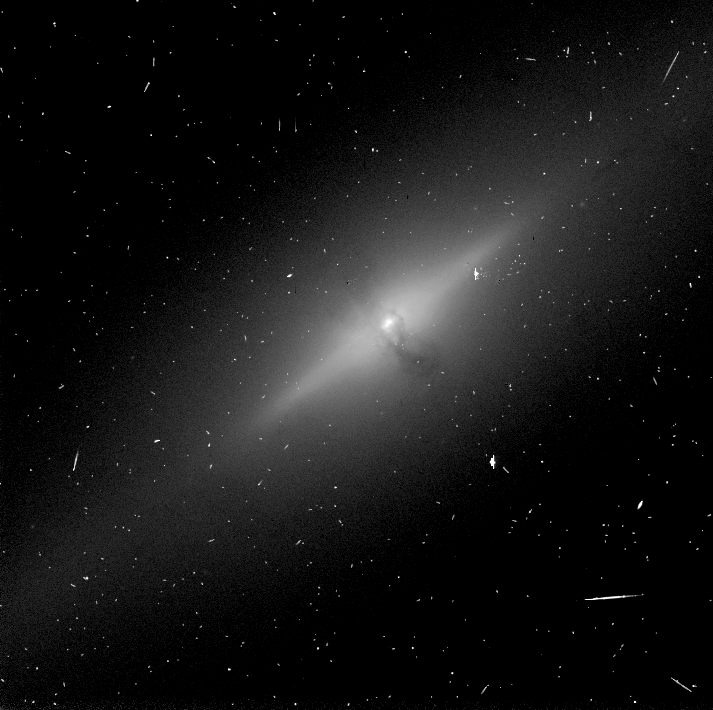
And in some others, the dust is nicely wrapped into tight spirals nearly at right angles to the main disk, a clear sign that the dust and associated gas were dumped in from somewhere else (the poster example for this is NGC 2787).
For more technical detail on some of these issues, I have course pages on these related topics:
Last changes: 6/2006